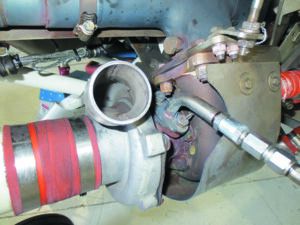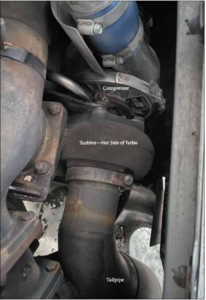Full disclosure—we have a bias when it comes to turbosuperchargers. We like them. A lot. After flying them for more than 45 years and using them to get to altitudes that allowed a safe flight when we could not have even launched in a normally aspirated machine, we think that they are we’ll worth the cost of care and feeding. That’s above and beyond the comfort they have given us during mountain operations and high and hot takeoffs. Apparently, our opinion is consistent with the historical market as turbocharged singles and twins have outsold their normally aspirated kin.
BACKGROUND
We call them by several names—turbo and turbocharger are shorthand for a turbosupercharger, which is a supercharger spun by a turbine in the exhaust system.
They’ve been around in aviation for over 100 years; in 1920 an Army test pilot climbed to over 33,000 feet in a LePere biplane powered by a Liberty engine equipped with a General Electric turbocharger. Cessna is credited with successfully bringing turbocharging to general aviation in the Model 320 in 1962.
Hartzell is currently the sole supplier of turbos in the U.S. Feedback from the field has been that Hartzell has cleaned up the quality control issues that it inherited when it took over Kelly Aerospace, which had acquired the Garrett and Rajay lines of turbos.
THE BASICS
A turbocharger is an air pump that sends compressed air to the engine intake system. Half of it is a turbine that lives in the hellish environment of the exhaust system—its wheel is spun by those fiery gases. When fully engaged it can spin at over 100,000 RPM and glows brightly enough for a person to read a book.
The turbine wheel shaft extends through the center housing into the cold side, where it spins the pump that compresses the ambient intake air and jams it into the induction system, allowing more power to be developed.
TWO VERSIONS
There are two distinct underlying designs of turbo system. In one, the engine develops sea level manifold pressure up to a selected altitude—it’s referred to as a turbonormalized engine. In the other, a boosted or “blown” engine, the engine can develop greater than ambient manifold pressure up to an altitude at which the system can’t compress the ambient air enough and manifold pressure starts to drop, the engine’s critical altitude.
A wastegate—the butterfly valve in the exhaust pipe upstream of the turbo—routes air either down the remainder of the tailpipe or diverts it into the turbo, or some mixture of the two. When closed, it all goes into the turbo.
Some wastegates are fixed—the pilot controls power with the throttle—and some are manual—there is a second control in addition to the throttle that the pilot must use in setting power. However, most are automatic—a controller senses the pressure of the air in the upper deck of the induction system, just upstream of the throttle body, and uses engine oil pressure to set the position of the valve in the waste-gate to maintain the manifold pressure the pilot has commanded with the throttle. Properly adjusted, an automatic system requires no action by the pilot during a climb or descent—which is not the case with a fixed or a manual wastegate.
When you discover that your system can’t make the promised manifold pressure at altitude, it doesn’t mean it’s time for an overhaul. According to Scott Utz, director of maintenance at Arapahoe Aero on Denver’s Centennial Airport, turbos hold up quite well—most of the time the problem will be something other than the turbo. See the sidebar on the next page.
PREVENTIVE MAINTENANCE

Utz pointed out that routine, preventive maintenance that keeps the engine happy is good for the turbo system as well. Keeping the air filter clean is good in general—on a turbo something as basic as a dirty filter means less air into the compressor, resulting in lower manifold pressure at altitude.
Even with the impressive metallurgy and high-temp alloys used in their manufacture, the environment in which wastegates live mean that they sometimes fail.
Otherwise, turbos do wear out and lubrication lines get plugged with coked oil—the result of the heat and speed at which the wheels are turning. That usually means it’s overhaul time.
EXPECTED LIFE
We heard from owners and shops and spoke with Gary Main, proprietor of Main Turbo (www.mainturbo.com), a turbocharger overhaul shop, regarding expected life of turbos in service. From owners and shops we got a 50-50 split. Half said their turbos made it to TBO before needing overhaul, the others said they usually made it about halfway.
Gary Main told us he was not surprised by the split. He said that the big turbos in the T210 and big twins are “strong and robust” and regularly make it to TBO. Where big power is demanded from the smaller ones, such as in a Cirrus, Piper Malibu or Aerostar, they don’t hold up as well. If the airplane is used for training or large, fast power changes are the rule, the turbo is more likely to expire prior to TBO.
Depending on the model of the turbocharger, overhaul costs start at $2500 for a T210 and go up—figure on at least $3700 for each one on a twin Cessna. It gets very ugly for the Aerostar as $4500 is the starting point and there are two per engine.
Nevertheless, historically the cost of operating a turbocharged airplane has run only about 15 percent more than its normally aspirated cousin—inexpensive, in our opinion, for the added capability. We saw nothing to change that number.
PROPER OPERATION
The bad news is that there are a couple of misconceptions about turbo system operations among pilots, and they may be reducing turbocharger life.
First, a lot of pilots assume that the turbo is not spinning during low-power operation, such as on landing or during taxi. That is absolutely incorrect—there is always some exhaust gas going to the turbo, so it’s turning.
Second, a surprising number of pilots did not know their airplane had limits on allowable manifold pressure above a certain altitude. Most know about critical altitude—the highest altitude at which the turbo will allow the engine to produce rated manifold pressure. However, at some point above critical altitude, the pilot must comply with a table that shows the maximum allowable manifold pressure and reduce power accordingly.
For example, a Cessna 414A has published maximum manifold pressures for all altitudes above 20,000 feet. That’s because the turbine blades are spinning so fast and get so hot that they stretch—it’s called blade creep—and, if the maximum manifold pressure for the altitude is exceeded, there’s a high risk they will rub against the housing, causing rapid erosion. Ignore it and get welcomed to an early overhaul.
OVERSHOOT

Because oil pressure controls the wastegate on an automatic system, it’s not unusual for the manifold pressure to overshoot—exceed redline—on the first takeoff of the day if the oil is still cold. The system is just sluggish. There is a popoff valve that should open to stop the manifold pressure from exceeding more than a few inches above redline and damaging the engine. It’s not a good idea to rely on the popoff valve—monitor manifold pressure on takeoff and stop it at redline.
With a fixed or manual wastegate, the pilot has to set power—and because it takes a few moments for the turbo to spin up from its relatively low RPM during taxi and runup, the manifold pressure will lag behind throttle movement. Experienced pilots learn to stop throttle movement at some point below the target manifold pressure. Overshoot increases with takeoff elevation—we’ve seen it exceed 15 inches of manifold pressure on a takeoff from Leadville, Colorado, in a Turbo Arrow.
CRUISE
In cruise, back off a bit from a power setting that generates maximum Turbine Inlet Temperature (TIT). Turbo overhaulers and mechanics told us to back off at least 20 degrees to extend the life of the system, be it lean or rich of peak.
Make all power changes gradually. After landing give the turbo time to spool down.
At shutdown, the oil flow to the turbo ends and a hot turbo will coke the oil in the unit. That can eventually plug oil galleys and cause turbo failure.
Many POHs call for a five-minute idle spooldown time after reaching parking. However, research performed on a Cessna Skymaster and more recently by GAMI produced the not surprising information that the turbo is the coolest it is going to get just after touchdown—unless there’s been a high-power approach and chopped throttle.
The turbo heats up during taxi in. The conclusions were that unless you approach at high power, chop the throttle and taxi a short distance—by the time you reach parking, the turbo has spooled down to an RPM suitable for shutdown.
CONCLUSION
After nearly 60 years in regular use in general aviation airplanes, we believe turbochargers have proven their worth and reliability for pilots who want to use their airplanes for more than just recreation.
They don’t require any extraordinary care beyond what you would do to properly operate the engine. However, when there is a problem, failing to carefully troubleshoot it can send costs skyrocketing if a mechanic just starts replacing parts.





